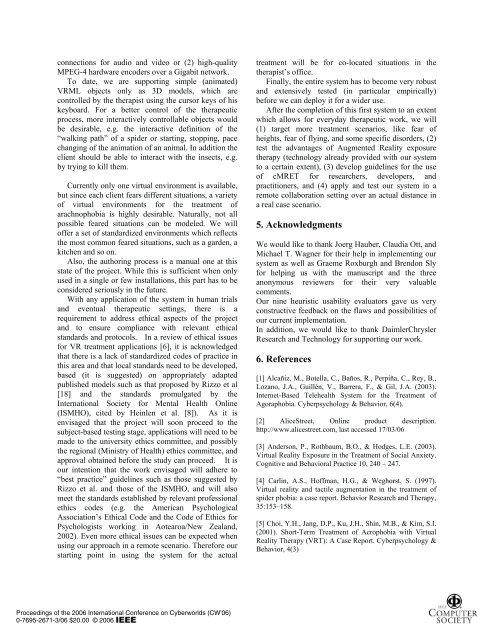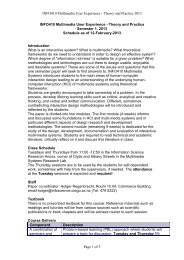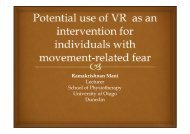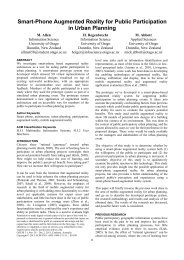View - HCI
View - HCI
View - HCI
You also want an ePaper? Increase the reach of your titles
YUMPU automatically turns print PDFs into web optimized ePapers that Google loves.
connections for audio and video or (2) high-qualityMPEG-4 hardware encoders over a Gigabit network.To date, we are supporting simple (animated)VRML objects only as 3D models, which arecontrolled by the therapist using the cursor keys of hiskeyboard. For a better control of the therapeuticprocess, more interactively controllable objects wouldbe desirable, e.g. the interactive definition of the“walking path” of a spider or starting, stopping, pacechanging of the animation of an animal. In addition theclient should be able to interact with the insects, e.g.by trying to kill them.Currently only one virtual environment is available,but since each client fears different situations, a varietyof virtual environments for the treatment ofarachnophobia is highly desirable. Naturally, not allpossible feared situations can be modeled. We willoffer a set of standardized environments which reflectsthe most common feared situations, such as a garden, akitchen and so on.Also, the authoring process is a manual one at thisstate of the project. While this is sufficient when onlyused in a single or few installations, this part has to beconsidered seriously in the future.With any application of the system in human trialsand eventual therapeutic settings, there is arequirement to address ethical aspects of the projectand to ensure compliance with relevant ethicalstandards and protocols. In a review of ethical issuesfor VR treatment applications [6], it is acknowledgedthat there is a lack of standardized codes of practice inthis area and that local standards need to be developed,based (it is suggested) on appropriately adaptedpublished models such as that proposed by Rizzo et al[18] and the standards promulgated by theInternational Society for Mental Health Online(ISMHO), cited by Heinlen et al. [8]). As it isenvisaged that the project will soon proceed to thesubject-based testing stage, applications will need to bemade to the university ethics committee, and possiblythe regional (Ministry of Health) ethics committee, andapproval obtained before the study can proceed. It isour intention that the work envisaged will adhere to“best practice” guidelines such as those suggested byRizzo et al. and those of the ISMHO, and will alsomeet the standards established by relevant professionalethics codes (e.g. the American PsychologicalAssociation’s Ethical Code and the Code of Ethics forPsychologists working in Aotearoa/New Zealand,2002). Even more ethical issues can be expected whenusing our approach in a remote scenario. Therefore ourstarting point in using the system for the actualtreatment will be for co-located situations in thetherapist’s office.Finally, the entire system has to become very robustand extensively tested (in particular empirically)before we can deploy it for a wider use.After the completion of this first system to an extentwhich allows for everyday therapeutic work, we will(1) target more treatment scenarios, like fear ofheights, fear of flying, and some specific disorders, (2)test the advantages of Augmented Reality exposuretherapy (technology already provided with our systemto a certain extent), (3) develop guidelines for the useof cMRET for researchers, developers, andpractitioners, and (4) apply and test our system in aremote collaboration setting over an actual distance ina real case scenario.5. AcknowledgmentsWe would like to thank Joerg Hauber, Claudia Ott, andMichael T. Wagner for their help in implementing oursystem as well as Graeme Roxburgh and Brendon Slyfor helping us with the manuscript and the threeanonymous reviewers for their very valuablecomments.Our nine heuristic usability evaluators gave us veryconstructive feedback on the flaws and possibilities ofour current implementation.In addition, we would like to thank DaimlerChryslerResearch and Technology for supporting our work.6. References[1] Alcañiz, M., Botella, C., Baños, R., Perpiña, C., Rey, B.,Lozano, J.A., Guillén, V., Barrera, F., & Gil, J.A. (2003).Internet-Based Telehealth System for the Treatment ofAgoraphobia. Cyberpsychology & Behavior, 6(4).[2] AliceStreet, Online product description.http://www.alicestreet.com, last accessed 17/03/06[3] Anderson, P., Rothbaum, B.O., & Hodges, L.E. (2003).Virtual Reality Exposure in the Treatment of Social Anxiety.Cognitive and Behavioral Practice 10, 240 – 247.[4] Carlin, A.S., Hoffman, H.G., & Weghorst, S. (1997).Virtual reality and tactile augmentation in the treatment ofspider phobia: a case report. Behavior Research and Therapy,35:153–158.[5] Choi, Y.H., Jang, D.P., Ku, J.H., Shin, M.B., & Kim, S.I.(2001). Short-Term Treatment of Acrophobia with VirtualReality Therapy (VRT): A Case Report. Cyberpsychology &Behavior, 4(3)Proceedings of the 2006 International Conference on Cyberworlds (CW'06)0-7695-2671-3/06 $20.00 © 2006










